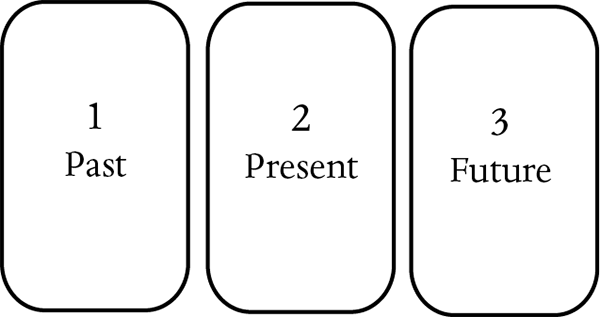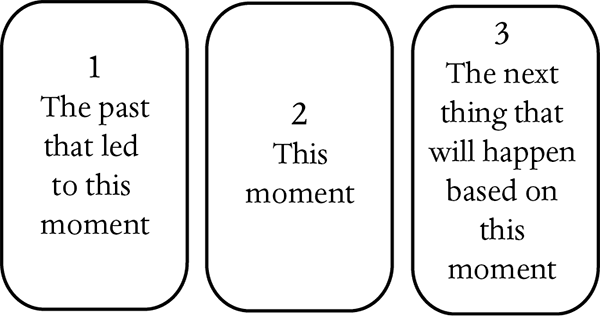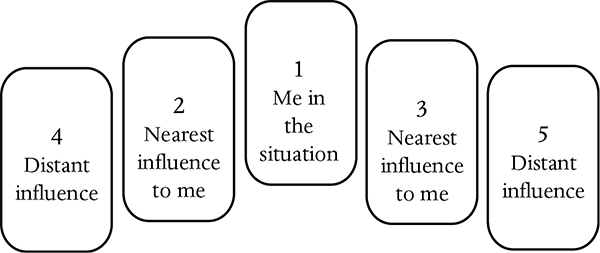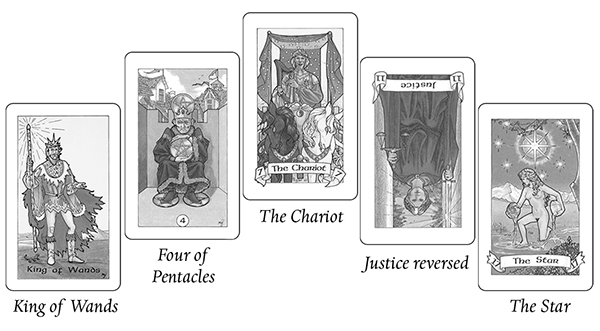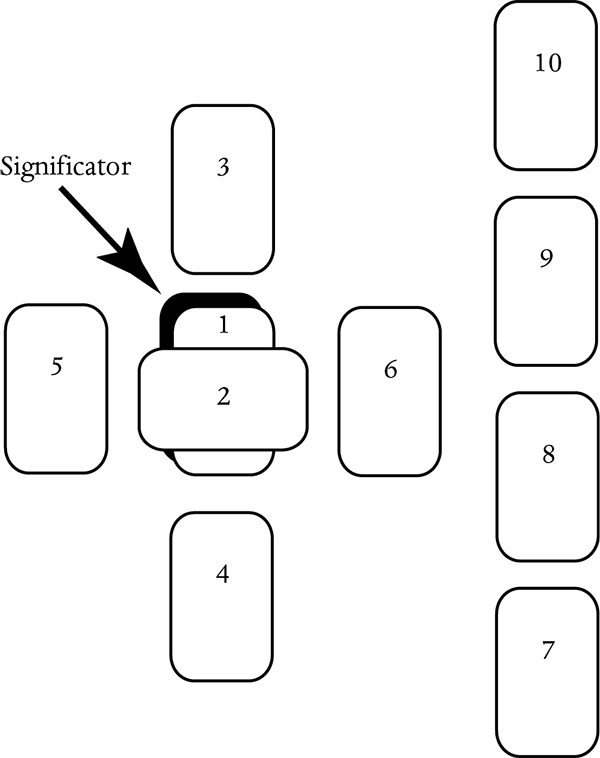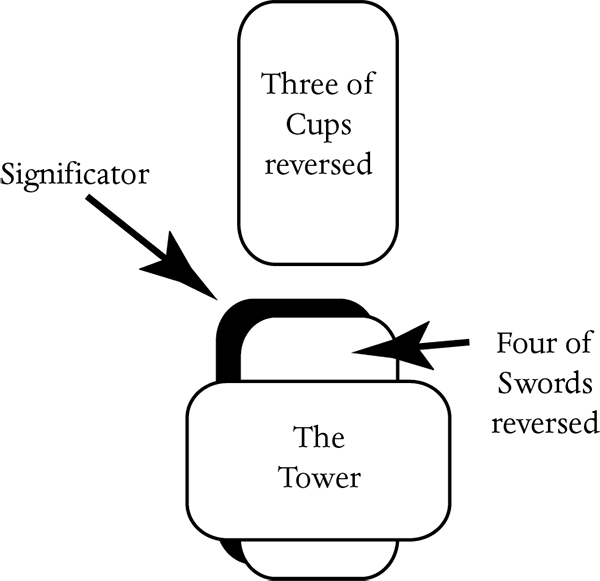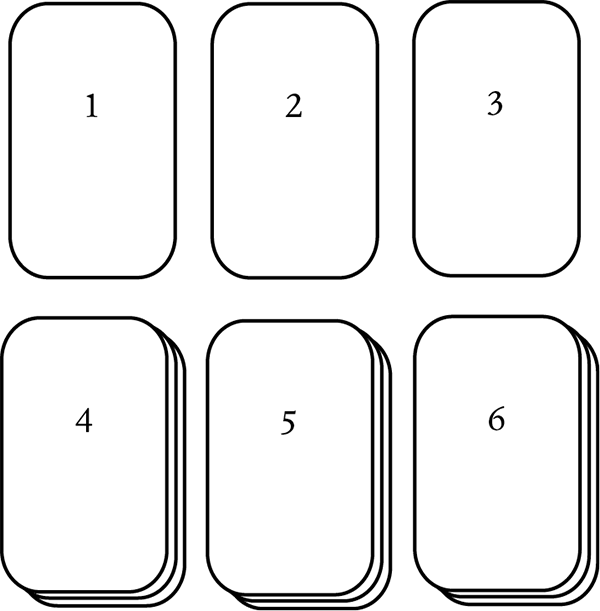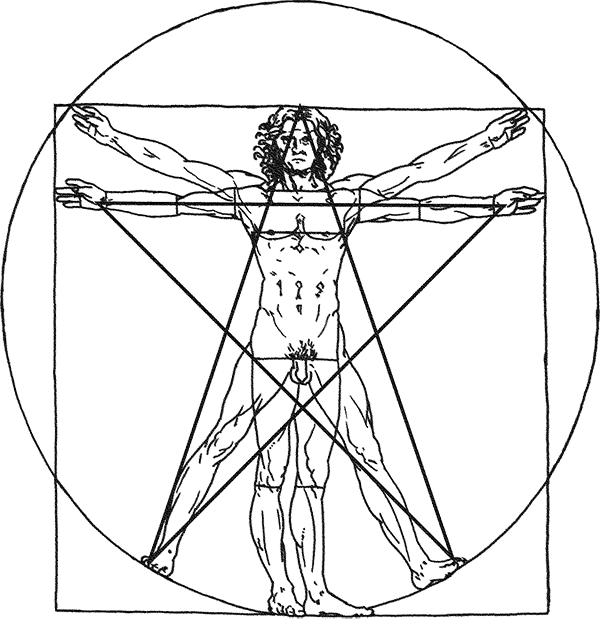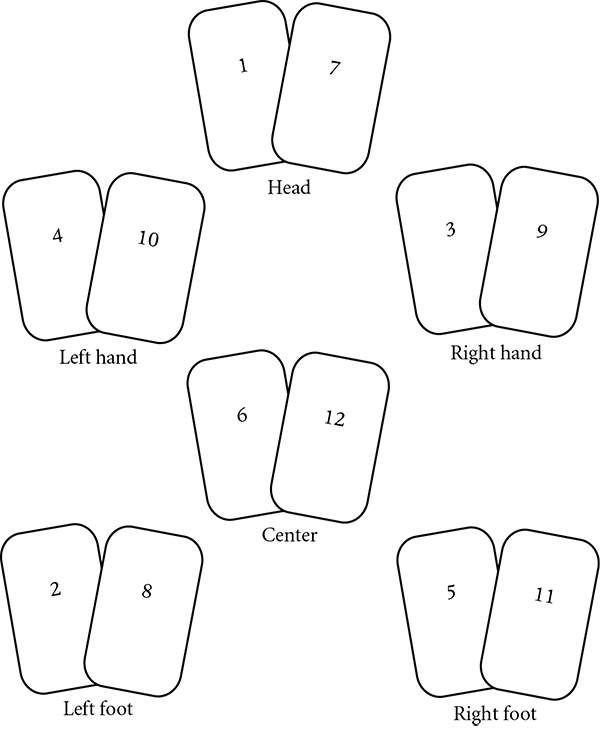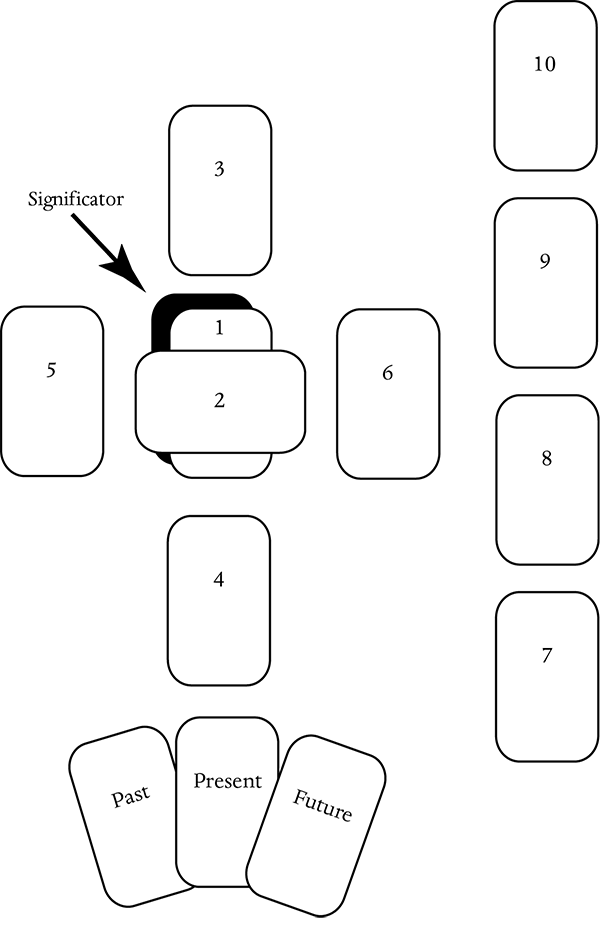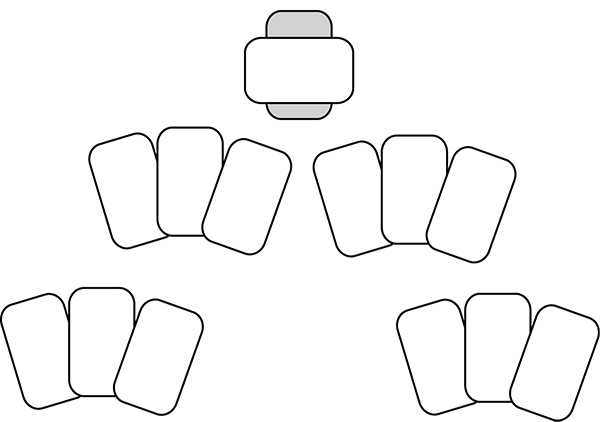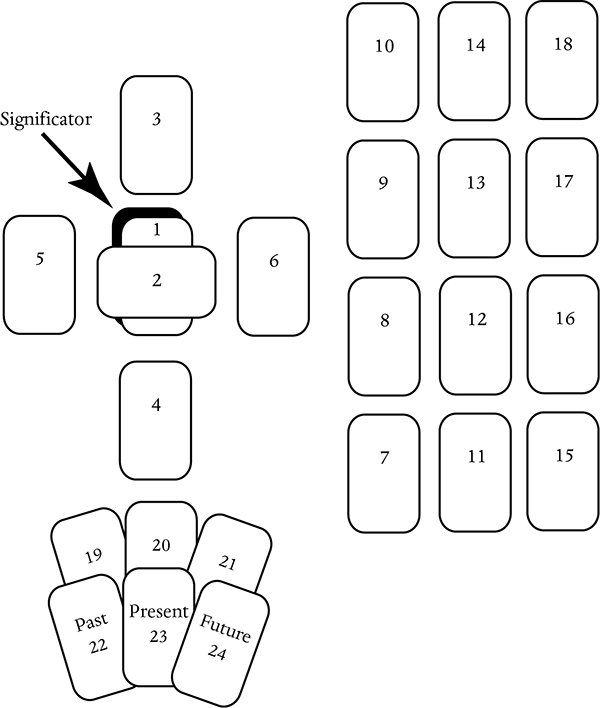Interactions
with Layout and Position
Most of the time, when you read cards, you’re reading them in a set layout. Therefore, the card’s meaning must interact with the position of the card within that layout. This is the beginning of truly interactive tarot, as cards change meaning and tone from here on out. As we move in our study of cards through interactions with their positions, and, in our next chapters, with each other and with the story being told, we’ll see that an infinite number of meanings can be discovered, not through memorization (which would be impossible) but through a moment-by-moment unfolding.
Types of Layouts
There are probably as many, if not more, card layouts (also called “spreads”) as there are available decks. Readers make up their own all the time, and you can even make them up on the fly. Layouts can be complex, encompassing a whole life, in the way that an astrological chart can be used to read a person’s life (there are tarot readings based on astrological charts, too). Other spreads can be deceptively simple.
Personally, I favor shorter, more direct layouts. Over the years, I’ve come to structure consultations around multiple short layouts rather than one big “tell me everything” layout, but this is entirely a personal preference.
A spread can cover every possible situation, or it can be simple and broad. You can have a general position like “nearby influence” or a detailed series of cards in positions for “unknown influence,” “unknown danger,” “influence of fate,” and so on. It’s good to have at least a few layouts in your repertoire that cover different needs in a reading. I have four or five such spreads I go to again and again, despite having studied many more than those.
Think of layouts in terms of the need they fulfill.
1. A full-life chart layout.
2. A snapshot layout: What’s going on right now?
3. A decision layout: What should I/the querent do?
Full-Life Layouts
As I said, this spread is like reading a birth chart, and one method of doing this reading is to lay out the cards exactly as if it were an astrological chart. Obviously, if you’re an astrologer, this is going to be a great reading to add to your bag of tricks.
The method is simple enough: Shuffle the deck and lay out one card for each astrological house, beginning in the first house (in the nine o’clock position) and going around all twelve houses counterclockwise. Then read each card as if it’s in the house. You can even overlay known information about the querent’s chart onto the reading. For example, my Sun is in my seventh house, so you could add an extra “Sun” card to the seventh position. (I don’t mean to pull out the major arcana Sun, I mean a randomly drawn card representing the astrological “planet” of Sun.)
Some people use only major arcana for full-life readings, and some use a deck that includes only twenty-two cards for such readings.
Another full-life method is to shuffle the twenty-two majors and lay out all of them, reading in order as if the cards tell the story of a journey from birth to today, or from birth to a date in the future that you pick.
Full-life readings aren’t something I use in my own tarot practice, so I don’t have a lot of insight to share. If this type of reading interests you, you’ll find there are many excellent resources. Eden Gray’s Mastering the Tarot, for example, has a section on a horoscope-type reading. You’ll find that the information explored in this chapter about other layouts will illuminate your work with full-life readings, if you choose to explore them.
Snapshot Layouts
These kinds of spreads give a picture of the querent’s life as it is right now. Generally, they include information about the past and future, not just the present. Sometimes a snapshot will include information about what the querent might or should do, giving it some overlap with a decision layout. Most beginning readers start with a variation on the Celtic Cross layout, which is a snapshot spread.
Past-Present-Future Layout
Note: I would not advise using a significator in a three-card reading.
A three-card Past-Present-Future reading is about as simple a snapshot as can be. I often use it in conjunction with other layouts (more on that in a bit).
Shuffle or mix the cards, and lay one card in each position in the order shown (illustration 17). The card on the left represents the past, the center card is the present, and the right-hand card is the future.
How a Card Changes in a Position
The Past-Present-Future reading gives us the easiest way to understand how the meaning of a card changes in a position: the tense changes. Here are a couple of examples: 6
Ten of Swords: Defeat.
Ten of Swords in the Past: In the past, you were defeated.
Ten of Swords in the Present: You are currently experiencing a defeat; you feel utterly defeated right now; a recent defeat is affecting you currently.
Ten of Swords in the Future: You are about to face a major defeat; a situation you are entering into will end in your defeat; the competition or combat you are currently experiencing will end in your defeat.
Hanged Man Reversed: Unwillingness to face the hard work needed in order to achieve a goal; laziness; taking the easy way out.
Hanged Man Reversed in the Past: In the past, you chose an easier path; you skipped out on some hard work.
Hanged Man Reversed in the Present: You are not willing to face the hard work needed in order to achieve your goals; you are avoiding personal sacrifice.
Hanged Man Reversed in the Future: You are going to face the need to work very hard, at personal sacrifice, in order to achieve a goal, and it looks like you will be unwilling to do that.
These are very simple interpretations of how reading a card changes based on position. It’s easy to realize that placing “defeat” in the past means “you were defeated.” This simple example, though, will pave the way for more complex shifts based on position.
At this point, these cards are still kind of hanging in space, standing alone with their meaning. You have shifted the meaning of a card based on where the card is, but it is not yet truly interactive.
The most important thing to understand about a layout is that all the cards are in the same layout. They are connected. They interact.
Let’s use the exact same layout, but change how we describe the cards (illustration 18).
Now you can see that the layout is not three unrelated cards, and the cards do not depict just any past, or any future. Everything comes down to the present moment. The present is a lens through which we view the past and see the future.
Usually, the interaction between past and present in a reading is “and therefore” or “but now.” Any card in the present condition that can flow naturally from the card in the past condition is an “and therefore” interaction. Any card in the present that seems to contradict the past is a “but now.”
Let’s look at a couple of past-present combinations:
Past: Ten of Swords/Present: The Sun: In the past, you were defeated, but now you feel a new day is dawning, and you’re finally ready to let go of the wound you suffered.
Past: Ten of Swords/Present: Nine of Wands: In the past, you were defeated, and therefore, you are now guarded, cautious, and distrustful.
You don’t actually have to say the words “but now” or “and therefore,” but if it helps you focus on the interaction between past and present, then do so.
The interaction with the future is often also “and therefore.” It can be “watch out for” as well. If a future outcome is negative, I like to show the querent her options. In the case of a Ten of Swords in the future, she might not be able to avoid the defeat, particularly if the competition or combat is already in play. But with the Hanged Man reversed, laziness is a decision, so I can tell the querent that she might be lazy, or “it looks like” she will. Based on one card, I don’t even know if laziness is the wrong decision for her. If the Hanged Man reversed in the future follows a Ten of Swords in the present, she might not be strong enough to handle the hard work, and taking an easier path might be the smartest possible decision, based on the wounds she’s currently experiencing.
Another way of looking at Past-Present-Future is as an unfolding, an act of becoming:
The past, which was [card], became the present, which is [card]; next, it will become [future card].
One reason I always use layouts in which the present, or the querent, or the situation, is in the center is because everything emanates from it, in all directions. There are two directions in this simple reading, but I like to keep that emanation-from-the-center principle in every reading.
If a querent doesn’t like the future, he can change the present, because the future is emanating from the present. If the querent doesn’t understand the present, look for causality in the past. If the querent understands a decision he made in the past, he’s better able to change that decision, which impacts the present and the future.
Let’s keep going with our examples:
Past: Ten of Swords/Present: Nine of Wands/Future: Seven of Swords: In the past, you were defeated, and therefore, you are now guarded, cautious, and distrustful. It’s a good thing you’re so guarded, because the future brings a theft or deception, perhaps from the same source that wounded you in the past.
Past: Ten of Swords/Present: Nine of Wands/Future: Five of Cups: In the past, you were defeated, and therefore, you are now guarded, cautious, and distrustful. The future shows a deep sense of loss, disproportionate to the actual loss. The Five of Cups is someone grieving over a loss even though the person still has plenty—your guardedness today may be distorting your vision, and this looks like it will cause you pain in the future.
Here are two different future cards that completely change the meaning of the present card. If the future needs to be guarded against, then a cautious card in the present makes sense and is positive. If the future brings emotional pain, then perhaps the root of that pain is in the present or the past, and it’s time to unravel the thread of defeat that leads to that future.
Note also that it makes sense to relate the Seven of Swords to the Ten of Swords, and not just because they are the same suit (and therefore a pattern). The future and the past are connected. You can expect a relationship among all the cards, especially in a small reading.
Changing the Time Sequence
What if you want a time sequence that isn’t past-present-future, or is more specific than just past-present-future? The simple answer is to declare in advance what the reading will be, and then stick to that.
Here are some examples:
• Yesterday-Today-Tomorrow
• January-February-March
• Yesterday-Next Month-Six Months from Now
It’s important, though, not to revert to a more nebulous “past” if the card doesn’t immediately resemble what actually happened yesterday. Readings like this can be stressful for the Psychic Child, who awaits the moment when you doubt her. When your timeline is specific, there’s room to doubt, and that can be nerve-wracking.
Instead, be firm. Be committed to the fact that your chosen meanings are the meanings of these positions, and you’ll find that you’ll be able to work within those parameters.
Of course, you may find it simpler to tweak the layout, so that January-February-March looks different from Past-Present-Future. For example, you could do something as simple as using a straight line of three cards (as in illustration 18) when you mean Past-Present-Future, while using a fanned layout when you mean months, or vice versa. Or you could imagine months as being in the positions of the twelve numbers on a clock, and place “month” cards in the correct spot of the circular clock face you are visualizing: 1, 2, 3 for January-February-March.
Influences Layout
Note that if you use a significator in this layout, it goes in position 1, and then the first card is placed directly on top of it.
This snapshot layout answers the question “What is going on around me?” (with “me” being the querent). I used a variation on this for the court cards reading in chapter 3 (illustration 15).
An influence, in this layout, can be a person, a memory, a relationship, a job—it’s a very open-ended word. Sometimes I vary this layout by using the principle that the left side is the unconscious and the right side is the conscious, so cards 2 and 4 are influences the querent is not aware of, while cards 3 and 5 are influences the querent already knows about.
This is also a simple layout in terms of seeing how a card’s meaning will change according to its position. Remember that when you study card meanings from any book or guide, you’re learning them as if they are the central card. Virtually every meaning in any book you study will fit well in position 1 in the Influences layout, but you’re going to be shifting the meanings of the other four cards.
Sample Reading: Influences Layout
The following is a reading I did for someone “blind,” which is to say, she didn’t tell me her question until after the reading was over (illustration 20).
Before I began reading the cards, I noticed a pattern and said to the querent that the presence of three majors indicated the reading was very important to her and involved her understanding of who she was as a person. She agreed.
Position 1: Me in the situation
Chariot: Control, mastery, the need to maintain strict control to prevent chaos.
Chariot in Position 1: The question is about your ability to control the situation; you feel you have to hold on tight and work very hard or chaos will ensue. Notice how similar this is to the meaning of the card.
Position 2: Nearest influence you don’t know about
Four of Pentacles: Miserliness; greed; grasping tightly to what you have and failing to see that you could have more.
Four of Pentacles in Position 2: A greedy person or institution is the biggest hidden influence on your need to maintain control, or it’s your own short-sighted attitude that is the hidden influence.
Here, I advocated for the hidden influence being a subconscious attitude, while my querent was sure it was an outside party. I felt like the outside party wasn’t a hidden influence, since she was well aware of it, and thus we were talking about a subconscious attitude—the card represented the way she was holding tightly to the Chariot’s reins, and was telling her that she wasn’t seeing outside opportunities as a result. She disagreed.
Position 3: Nearest influence you are aware of
Justice Reversed: Injustice.
Justice Reversed in Position 3: You’ve been screwed. You’re not being treated fairly. The reason you have to struggle so hard is because of the way you’re being treated.
Here, we’re certain that it’s an outside party that is committing the injustice. If the card was in position 1, it might have been the querent committing the injustice, or it might have been that the question was about a legal concern or about the injustice itself.
Position 4: Distant influence you may not know about
King of Wands: A powerful man connected to wand concerns (building, establishing, working, creating).
King of Wands in Position 4: There is a powerful man pulling strings and advocating for you, helping you through this situation. He’s not a money guy—he’s not someone in finance or payroll; he’s related specifically to your work.
Position 5: Distant influence you’re aware of
The Star: Physical, psychological, and spiritual well-being; health; balance.
The Star in Position 5: Maintaining your health and well-being is important in order to keep going. The situation requires strength, energy, and focus. If anything happens to your health, you won’t be able to keep going, and this is a concern of yours. You can see that the Chariot’s intensity requires the support of the Star.
After the reading was finished, the querent told me the question was about work. She is an adjunct professor and is angry about institutional greed that prevents her and her colleagues from being well-paid or advancing in their careers. She carries a heavy course load that can be exhausting. She has a dean she is friendly with, whom she has long suspected of pulling strings behind the scenes to make sure she has enough classes to support herself.
Let’s think about what this sample reading taught us about reading a card based on its position. Position 1 was the situation/question/querent in the context of the question. It is “me as I ask this question.” Every other card is an influence and therefore secondary. Every other card must refer back to the first card.
The grasping quality of the Four of Pentacles thus relates back to the Charioteer’s grip on the reins. The King of Wands is an advocate who helps the querent maintain control of the reins. Justice reversed is the reason the querent has to struggle so hard, and the Star is necessary to continue the struggle. Every secondary card is read in relation to the central card. You can say that secondary cards interact with the primary card, just as you can say that a card interacts with its position in the layout.
Exercise: Relating Cards to One Another
In the previous reading, I stated: “Every other card must refer back to the first card.” This exercise is your opportunity to work on that, using the same Influences spread. You can do this reading for yourself or a willing friend. Read out loud even if you are alone.
1. If you are using a significator, pull it from the deck and place it before you.
2. Then begin with several deep, cleansing breaths, and center yourself.
3. If you are alone, ask your question out loud. If you are reading for someone else, allow them to choose whether they will ask a question out loud or keep it private.
4. Shuffle the cards until you feel it’s time to stop.
5. If you are reading for a querent, let the querent shuffle also.
6. Lay out five cards as shown in illustration 19.
7. Look for patterns first, sharing anything you see with the querent (or reading out loud if alone).
8. Read card 1: Me in the situation.
9. Read cards 2 through 5. Each card should be related back to card 1. Your task is not to remember the meaning of each card—you should already know that. Your task, instead, is to interpret each card as if it is secondary to card 1: What is card 2’s relationship to card 1? What is card 3’s relationship to card 1? And so on.
10. Draw your conclusion. How does finding a conclusion help relate cards 2 through 5 back to card 1, to tell a single story?
11. Record your results in your journal.
Celtic Cross Layout
The Celtic Cross layout is the most familiar and wide-ranging snapshot spread, and it’s the one most tarot readers learn first (illustration 21). Almost every book on the tarot has a variation on the Celtic Cross.
Keep in mind that there are many variations of this spread! From the order in which the “cross” portion of the reading is laid down to the meanings of individual card positions (especially in the “arm” portion), you’ll find numerous authors contradicting one another. Our focus here is on the interaction of a card with its position, so if you’ve learned a different version of this layout that you prefer, the lesson will still be of value.
Traditionally, the Celtic Cross is always laid out with a significator, which is placed beneath card 1 before the shuffle.
Position 1: Covering (the significator)—This is the situation, which is so closely aligned with the querent that it completely covers her. (This is why a significator is important in this spread. The entire reading will take place as if the querent is the significator and the cards surround her.)
Position 2: Crossing—This is what crosses the querent, what works against her interests, specifically in regard to card 1. The crossing card is always read as if reversed.
Position 3: Above—Known as the “crown” card, this is variously read as the goal, the best possible outcome, or the possible future (the future following card 10).
Position 4: Below—Known as the “foundation” card, this is the reality that the querent stands upon. It’s not the situation or the question, it’s the unquestioned background—like water to a fish.
Position 5: Behind—The recent past; this is anything that has happened in the past one to three weeks, and/or anything with a fading influence.
Position 6: Ahead—The near future; this is a prediction of something that will happen in the next few days.
Position 7: Environment—The people and things around the querent, including family, living companions, coworkers, job conditions, and so on. It’s not the querent and should never be interpreted as the querent’s inner life.
Position 8: Self-Image—Who the querent thinks she is.
Position 9: Hopes and Fears—This is a purely psychological card and should not be mistaken for a prediction or a description of how things really are.
Position 10: Outcome—This card answers the question. If there wasn’t a question, it indicates what the current actions will lead to. It adds up the past (card 5), present (cards 1, 2, and 4), future (card 6), and other conditions surrounding the querent (cards 7, 8, and 9), and says what the result will be if nothing is changed.
Let’s take a card—the Two of Pentacles (illustration 22)—and imagine it in each position. I’ll write up each position as if I’m describing the card to a querent. Pay attention to the way that the card stays the same and yet changes as a result of moving from place to place.
Two of Pentacles: Keeping things in balance. The juggler keeps things in balance by keeping his balls in the air.
Position 1: Covering—Your overriding concern right now is maintaining balance, keeping all your balls in the air. Right now you’re fine, and your focus is on making sure you stay fine.
Position 2: Crossing—Keeping balanced in the face of all the factors in your life is the thing that makes [meaning of card 1] harder. Staying in balance and keeping all these balls in the air works at cross-purposes to [card 1].
Position 3: Above—Your goal is to be in balance and to be able to manage all the facets of your life without apparent effort.
Position 4: Below—Here we see that your life is all about staying in balance. As you [reference back to card 1], your foundation is the effort to stay in balance.
The foundation card (position 4) might not make a lot of sense without referring to other cards, so I laid out three cards to give us a covering, crossing, and goal card (illustration 23).
Now we can read a foundation Two of Pentacles as follows:
Here we see that the foundation of your life is about staying in balance and also about juggling many things. The period of rest and reclusion you’re coming out of [Four of Swords reversed] must have seemed really unnatural and awkward to someone who is used to keeping many balls in the air. Fortunately, you are still that person and can draw on those abilities as you regain your bearings.
The Four of Swords reversed covers; the querent is coming to the end of a long rest, illness, or period of isolation. The Tower crosses; a disaster of some kind forces an end to exile, or perhaps the disaster is what pushes the querent out of exile—the other cards will tell the tale. The important thing is that the foundation card teaches us something of who the querent is: whatever the disaster, whatever the current period of rest and recovery, this is someone for whom balance and busyness are normal.
Suppose the Tower and the Four of Swords reversed were switched, with the Tower covering and the Four crossing. Then our interpretation would be something like this:
Here we see that the foundation of your life is about staying in balance and also about juggling many things. The disaster that has ripped through your life [Tower] is something that you have an ability to overcome—your foundation shows us that. The desire to get away from the stress and chaos and take a breather [Four of Swords reversed] won’t help you, but the balance and agility required to keep many balls in the air is exactly what you need.
Since the need for rest, repose, and contemplation (Four of Swords reversed) crosses the querent, we can assume it’s doing her no good. Her foundation here represents core inner qualities that can help her.
Position 5: Behind—You used to be really good at keeping things in balance.
This is an okay reading of the card in this position, but it’s kind of a “general past” interpretation. The Celtic Cross benefits from keeping very specifically to the stated meaning of each position. “Behind” is the immediate past, an event that happened or a person encountered. Here is a better reading:
In the recent past, there was a spate of responsibilities that forced you to stay on your toes and really juggle things, yet you were able to stay in balance.
Position 6: Ahead—You’re going to be called on to do a real balancing act in the next few days. Perhaps some extra responsibilities will be handed to you.
This is the obvious meaning, but sometimes this position in particular is a place where you can be really intuitive. Maybe the querent is going to meet an acrobat or a circus performer!
Position 7: Environment—The people around you are really balancing a lot of things right now.
Other cards will indicate why this is important. Perhaps the people around her are unavailable to be supportive of the querent. Perhaps the querent has always wished she could be as good at staying balanced as her coworkers or family seem to be. Perhaps she’s working in a general atmosphere of controlled stress. Look to the other cards to flesh this out. We’ll learn more about this in the next chapter.
Position 8: Self-Image—You see yourself as someone who is always handling a dozen things at once. You pride yourself on keeping it all together.
Position 9: Hopes and Fears—Deep down, you’re afraid you can’t handle all the things that are being thrown at you. You hope to be seen as serene and in balance, but you’re afraid you’ll look like a fool and become overwhelmed.
Position 10: Outcome—Despite [whatever negative cards are predicted], you’ll ultimately be able to handle everything with a sense of balance. Of course, if there aren’t any negative cards, you would read this differently.
The Two of Pentacles changed subtly throughout this reading. It remained itself, but as it interacted with its own position in the layout, the resulting interpretation of the card changed.
At the foundation, we also saw the beginning of how cards interact with one another, which will be the subject of our next chapter.
Decision Layouts
Most of the time these days, I use some sort of decision layout. A good decision reading often has many qualities in common with a snapshot reading; it tells you where you’re at now and what you’re doing, and contrasts that with an alternative. One of the following readings is “what you’re doing” versus “what you should be doing.” Another I use takes a different approach: “what will happen if you keep doing what you’re doing” versus “what will happen if you make a change.” These layouts work because most of the time when people are struggling to make a decision, they’re already inclined in one direction, and their behavior is already leading them somewhere. They just need to be told whether that’s the right direction.
Yes/No Layout
The simplest Yes/No layout is simply to shuffle and cut the deck, looking at the cut card. Upright is “yes” and reversed is “no.” You can use this for straightforward questions: Will my meeting start on schedule? Should we go to the movies tonight? Things where you don’t really need to read more meaning into the answer.
For a more nuanced Yes/No reading, I use the following six-card layout all the time (illustration 24). I first learned it from Eden Gray, and by now it’s second nature to me. It’s simple, it’s fast, it’s accurate, and it’s easy.
For this layout, don’t use a significator.
Shuffle the deck as usual, making sure to get those reversals in there. Cut three piles, from left to right. Flip over the top card of each pile and place above the pile. Those are your first three cards. Then flip over each pile so that the bottom card is face up. Now you have six cards. (It doesn’t matter if you flip a card/pile from bottom to top or sideways, as long as you always do it the same way.)
Now count the reversals. More upright and the answer is yes. More reversed and the answer is no. Three of each means the question cannot be answered at this time.
Now you can read the cards as in the Past-Present-Future layout (illustration 17). There are two cards for each position: positions 1 and 4 are the past, 2 and 5 are the present, and 3 and 6 are the future. They will explain the yes-or-no answer, but no matter what information you get from the cards, the yes or no is based on reversals only.
I find this layout refreshing. It lets me read a lot about the past, present, and future without letting the querent say, “But doesn’t that mean I should really … ?” Remember that a querent is already leaning one way or the other, and is looking for you to confirm what they want to hear. Sometimes you just can’t do that.
Reading in Sequence
We’ve seen three layouts so far in which the past, present, and future are read from left to right: this one (Yes/No), the three-card Past-Present-Future, and the Celtic Cross. Unless you read one of a handful of languages such as Hebrew, your eye naturally sequences information from left to right, because that’s the way you read.
Read layouts in sequence from left to right to allow your brain to process information in a way that seems natural. The sequence of events you see naturally, and the sequence of events that the layout describes, should match. If you invent your own layout or revise one you’ve found here or elsewhere, keep this in mind.
Also keep in mind that cards will tend to take this sequence even when there’s no explicit past-present-future in the reading.
In chapter 3, we looked at a sample reading for court cards (illustration 15). The layout used was a seven-card version of the Influences layout (illustration 19). The difference was, I put two cards in each of the “distant influence” positions. This gave a fuller spread of environmental concerns. With two cards side by side, even though there was nothing in the layout about time sequence, I naturally read them in sequence, so that the Two of Wands in that reading came before, and perhaps caused, the Knight of Pentacles reversed.
Another sequence the eye naturally understands is “above” and “below.” The Celtic Cross layout does a wonderful job of making this explicit; the querent seems to stand on the foundation, and the crown seems to be above his head.
When you see two cards one above the other, as you do in each section of the Yes/No layout in illustration 24, you’ll naturally see the bottom card as a kind of foundation, and the top card as standing on it, floating above it, or emerging from it. In other words, the bottom card will tend to come first.
In the sample layout in illustration 25, you can see that the answer is a strong yes, since only one card is reversed. What else can we learn?
A pattern emerges: Three court cards indicate that this is a decision involving people, or a situation with a lot of people around, perhaps a social event. Two kings indicate that authority and control are important. The Page and the Six of Cups both depict children/youth.
Remember that this layout differs from the other three-card Past-Present-Future layout in that there are two cards per period of time. In the past, we see waiting. If the Two of Wands was the only past card, we could say, You were waiting for news about an opportunity, and then look to the present and future to see how it turned out. Here, though, we see a Page of Pentacles as well. Waiting resulted in an answer about money (pentacles) from a student or young person or school (pages are often students). Since I’m reading for my professor again, this makes perfect sense.
To a certain extent, the meaning of the Page is altered by the fact that it relates to the Two of Wands. Instead of describing the person that the Page is, I describe him or her in relation to the Two. The two cards in each time period have to communicate the message of the reading as a single unit: these are the past instead of this is the past.
Similarly, the present shows a king on top of the Wheel of Fortune reversed. I see these two cards as being in contradiction to each another: the King is a controlling force, and the Wheel is that card in the deck that tells us that luck will have its way—not everything is under our control. Which is it? At the present moment, the querent doesn’t know.
Notice that only the present is uncertain; only the present has both a reversal and an upright card. The querent is uncertain at this moment, even though the past has been secure and the future will be secure.
When two cards in the same position contradict each other, we can perceive that as a mistaken belief: You think this King is in control, but really it’s all up to fate. Here I interpret the King in the above position to mean he is an idea, while the Wheel below is reality: a foundation is as real as the earth beneath our feet.
In the future, the Six of Cups comes from the King of Cups. There will be strong emotional satisfaction in the outcome; neither card has that meaning, but the future is 100 percent cups—two cards in two positions. This suggests that emotions will come into play, and with a positive reading like this, that’s how I interpret it. The King of Cups brings the querent to a future where happy memories are experienced.
Naturally, the professor was asking about school again, this time about classes that she would or would not be offered. Since she is an adjunct professor, each semester is fraught with stress about whether her schedule will allow her to make a living, and sometimes it’s pure luck. Fortunately, her answer and her actual outcome were positive.
Vitruvian Man Layout
This is my single favorite layout. I learned about it in a magazine article over twenty years ago—I don’t know who to credit for it—but it is wonderfully simple and rich.
The Vitruvian Man is the Leonardo da Vinci illustration of a man with his arms outstretched (illustration 26). The image seems to form a five-pointed star (a pentagram—not unlike the pentacles suit), as shown in illustration 27.
The layout of the Vitruvian Man is simple and easy to remember, because it’s easy to visualize the human body. The cards are placed as though you are drawing a pentagram, starting at the top (illustration 28).
I learned this reading with two cards in each position, although I often use it for a quick six-card reading. If you do the twelve-card version, lay out the pentagram twice, so that the head is cards 1 and 7, the left foot (always read from your own point of view) is cards 2 and 8, and so on.
One thing I love about this spread is the way that snapshot and decision cards are interspersed throughout. It’s also a layout that has practical and spiritual components.
Although the cards are initially placed as numbered, I tend to read them from either top to bottom (as in the following example), or left to right (in keeping with the natural sequencing discussed earlier). In any case, I always save the center cards for last.
Position 1/7: Head—Where your head is at. What you’re thinking. Your primary concern.
Position 4/10: Left Hand—What you’ve been doing. “Hands” in this layout indicate action. This position, the left hand from the reader’s point of view, is past/present actions.
Position 3/9: Right Hand—What you should be doing. This card is why I classify this as a decision layout. You have the opportunity, as a reader, to see if the two hands are very similar or very different.
Position 2/8: Left Foot—Where you stand. This is basically a foundation card, since it’s where the querent stands. But this spread emphasizes movement—the querent moves from this foot to the next, so it’s possible to look at how the querent’s life has changed in a broad sense. A foundation card in the Celtic Cross is stable, whereas this card is more like a step in life’s journey.
Position 5/11: Right Foot—Where you’re going. This is the future card. It’s important to look at the relationship between the right hand and the right foot—is the querent heading in the direction he should be?
Position 6/12: Center—What Spirit/God/the Gods want you to do. Normally you expect this card to be consistent with the right hand, but every now and then, this position will throw you a curve ball and make you rethink the entire reading. It can be a challenging layout for that reason.
The Vitruvian Man layout gives us the opportunity to see how to work with pairs of cards in a different way. Previously, we’ve seen side-by-side or top-and-bottom pairs. In this layout, the pairs of cards are placed in a fan.
Sample Vitruvian Man Reading
As usual, we can start the reading by looking for patterns (illustration 29). Sometimes it benefits a reading to wait until you’ve looked at the individual cards before looking for patterns, and sometimes the meaning of a pattern becomes clearer later in the reading. For the purposes of this book, we look for patterns first, but in real-life readings, you will do it in whatever order feels intuitively correct.
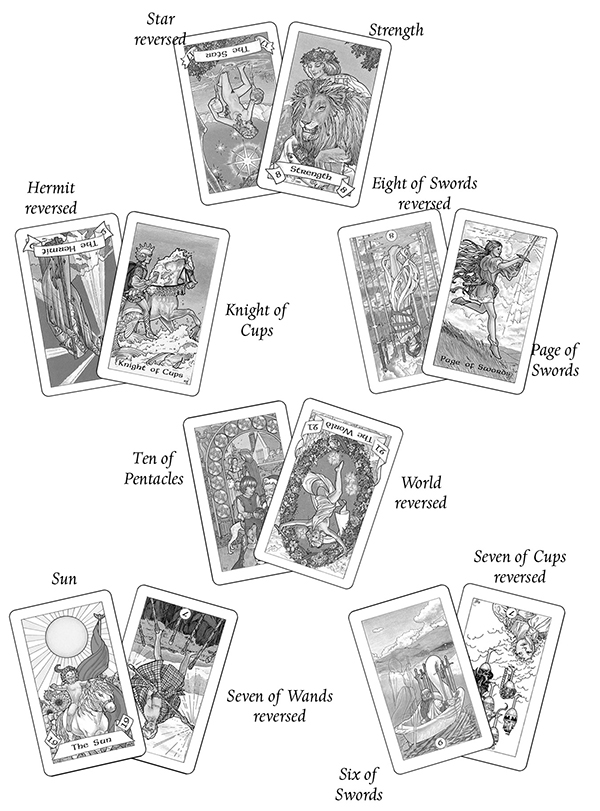
Illustration 29: Vitruvian Man Reading (Robin Wood Tarot)
There are five major arcana in this spread. Our handy Distribution of Cards chart (at the beginning of chapter 3) says that three or four are normal in a twelve-card layout, so this isn’t a huge anomaly. What’s interesting, though, is that both cards in the head position are majors. This indicates right off the bat that our querent thinks the problem is bigger and more important than it may actually be.
There are two sevens (both reversed) and two eights (including Strength). Any repeated number is statistically notable. Our keyword for seven is “willpower,” and for eight it’s “progress.” As an overview, we see that a lack of willpower on the querent’s part is impeding progress.
Position 1/7: Head
Star Reversed: General ill health, in body, mind, or spirit. A health crisis. Disconnection from the self or one’s spiritual nature. Pessimism and darkness.
Strength: Compassion. Spiritual strength through love rather than force.
Interpretation: You’re worried about your health and your own dark attitude. You’ve made an effort to become more compassionate and to bring that compassion into your life. Usually, when doing a reading, I’ll state the meaning of the position as I read each card, so it’ll be, Where your head is at—You’re worried about your health … I do this in each position.
How the Pair Works Together: We know these are huge concerns about life changes because both cards are majors. Because Strength literally overlays the Star reversed, we have reason to suspect that the querent is trying to overlay underlying fears with outward behavior; he’s trying to stuff the fears away by being loving and kind and so on.
Position 4/10: Left Hand
Hermit Reversed: This can mean leaving a “hermitage”—after a period of isolation—and reentering the world, or it can mean rejecting the advice of a guru or teacher; refusing to learn.
Knight of Cups: A man bringing love or a loving message into life. A Prince Charming.
Interpretation: You’ve ended a period of isolating yourself. You’re working on getting out into the world in a way that is loving and friendly.
How the Pair Works Together: The Knight of Cups allowed me to reject the “refusing to learn” option for the Hermit reversed; the reading in general is already clearly about the querent’s efforts to engage more with the world in a loving way. Get out of your dark, dreary head and love humanity can be a phrase that applies to both the head and left hand. We can understand now that the querent isn’t just thinking about engaging more compassionately, but is actively doing so. The Knight is a result of the Hermit. Notice that in a fan pairing (as opposed to two cards side by side), we see that the top card partially obscures the bottom card. In this case, the Knight covers the Hermit’s lamp. If we think of the Hermit as someone isolated, and his lamp as his wisdom or teaching, then the Knight’s placement supports the notion that we should discuss isolation (and its end) rather than see the Hermit as a teacher.
Position 2/8: Left Foot. Knowing this querent, and seeing what the cards had to offer, I wanted to make sure we thoroughly discussed past and present before we got into advice and future.
Sun: A happy child leaves the garden. Venturing out into the unknown, with joy and positivity. The present situation is safe and comfortable but childlike; the card indicates a willingness to move beyond the safe walls of childhood and venture into adulthood. Joy is within.
Seven of Wands Reversed: A failure to plan; the querent hasn’t taken high ground and is unprepared. The Seven of Wands shows a conflict in which the querent has high ground and will win; reversed, he has failed to prepare and is overwhelmed.
Interpretation: The Sun tells me that you’re ready to leave your garden. You’re fine and happy as a sheltered child, but you’re ready to grow up and venture out into the world, and that’s what your life has been about. You’ve made some real mistakes and you haven’t been prepared for the real world, and this has been a cause of some pain to you. Maybe the Seven of Wands reversed here is why you’ve got the Star reversed on your mind. It’s helpful, throughout a reading, to refer back to cards you’ve already read.
How the Pair Works Together: The Sun is working marvelously with the Hermit to affirm that the querent is expanding his life. The Hermit moves from isolation to connection, with the Knight of Cups forming loving connections (not necessarily romances), while the Sun moves from safety to the unknown. It looks like the first thing that has happened to the querent in this journey is that he’s gotten his ass kicked.
Just as the Knight obscured the Hermit’s lamp, here the Seven of Wands obscures the Sun’s victory banner: this tells us that the journey (the child on horseback) is important, but the success of the journey is not visible.
The querent has recently moved from his family home into his own apartment. He’s struggling financially. We see, though, that the struggle is less about money (there is only one pentacle in the reading) and more about connecting to the world.
When we get to the final cards, we’ll see that the querent struggles between an idealized life and a practical one. We can see the seeds of that with these two cards: the Sun is an idealized version of moving out, while the Seven brings the querent down to earth rapidly.
Position 3/9: Right Hand
Eight of Swords Reversed: The end of an illness or an abusive situation. Getting your sea legs back after an illness can be difficult. Release from fear or imprisonment.
Page of Swords: An agile young person. A dancer. A student of ideas, language, or dance. This card can also mean glibness, deception, or dishonesty.
Interpretation: The Eight of Swords seems to relate to both the Hermit and the Seven of Wands: You should be gentle with yourself. Your isolated period at your “hermitage” has left you a little weak, and you will naturally make mistakes. You should be strengthening your body as a way of strengthening your spirit. The Page of Swords suggests that physical activity will help move you toward the future you want. Here I took advantage of prior knowledge of the querent—since I knew he was considering taking dance classes, this card seemed like a direct reference to that. I’ve referred to the Page of Swords as the tarot’s dancer for years, and here it was, in the “should be doing” position, suggesting that dance would help the querent.
How the Pair Works Together: The Page seems to suggest a solution to the problem of the Eight. They’re both swords, indicating, in this case, movement. (Recall from chapter 3 that a pattern of swords indicates that the reading has a lot to do with aggression, conflict, speech, or argument, or that there is intense movement related to the reading.) Among the swords, these card aren’t particularly aggressive, violent, or conflict-oriented, and neither is the Six of Swords (position 5), the third sword in the reading. I think movement and change are the order of the day. The seven/eight pattern of this reading can be defined as “a lack of willpower impedes progress.” We’ve already learned a lot about the goals of this reading—movement away from isolation and out into the world, growing up, managing practical life better, and feeling less dark. Here we learn two things: the querent should be forgiving of his own flaws, just as a recently released prisoner should be expected to have a period of adjustment, and the querent should use physical activity, specifically dance, to feel more connected to the real world. My intuition tells me that physical movement will act on a non-physical level to help move the querent forward in all sorts of ways.
Position 5/11: Right Foot
Six of Swords: A journey away from sorrow.
Seven of Cups Reversed: Paralysis. Inability to make a decision.
Interpretation: Your journey is stalled by your inability to decide. It’s crucial that you make a decision—any decision—rather than stay paralyzed. Since the querent works in the tourism industry, I suggested that the Six of Swords—a card of travel—might represent his job, and his paralysis might be related to career.
How the Pair Works Together: With just the Six of Swords, a normal interpretation would be that the querent was about to take a journey or was planning a trip of some kind. However, paired with a card of indecision and paralysis, this seemed unlikely. When the two cards were read together, it seemed like a narrative about a delayed trip or an inability to choose what trip to take. The way the two cards are laid out, you can’t even see the journey, so I focused the reading on indecision. The seven pattern also indicated that this was the more important card.
Position 6/12: What Spirit wants you to do
Ten of Pentacles: All good things; a happy home, wealth, a loving family. Can also mean an inheritance or a family reunion.
World Reversed: Loss of possessions, both material and spiritual. Loss of position or rank. Can also be the refusal to learn lessons from life.
Interpretation: Here I was faced with a situation that is a huge challenge for many tarot readers: What do you do when a negative card appears in a positive position? If there’s something dark, unpleasant, or disastrous in a position designated as “what you should do” or “goal” or something like that, it can be challenging and confusing for both the reader and the querent. This is where understanding that the card and the position are interactive is vital. In this case, the interaction of the will of the Gods with a negative card was saying, Don’t do that. Do this instead. By the way, if you’re reading for someone who knows anything about the tarot, it’s helpful to draw attention to the conflict—the querent is already noticing it and worrying about it.
This position is what Spirit or the Gods want you to do. You’re probably wondering how the World reversed can possibly be what Spirit wants for you! But look at it next to the Ten of Pentacles. There’s all the good things in the world versus the World. Spirit is telling you to ground yourself in the reality of the minor arcana, rather than seeking after some fantastical version of perfect fulfillment. This brings us back to the beginning of the reading—the major arcana in the head position. Your thinking is all about big, important, world-shattering things, and you’re asking yourself to be perfect and amazing. What God wants of you is just to live a life—a happy, fulfilling life with family, children, and comfort. The cards here say to let go of seeking after the extraordinary, because it’s blinding you to how wonderful the ordinary can be.
Look at the Eight of Swords reversed. The advice of this card is to be gentle and forgiving of yourself. You need that advice because of these grandiose ideas you have about how awesome you’re supposed to be. See how it relates back to letting go of the World (which is the World reversed). The World card is as grandiose as anything in the deck—and Spirit says that’s not what your goal should be right now. Your goal should be the Ten of Pentacles.
There’s a lot more to say about this reading. We’ll be revisiting it and some other readings in the next chapter.
Expanding Upon a Layout
There are two ways I’ve expanded a layout: by design (planned in advance) and spontaneously (in the moment).
Dropping Cards
Sometimes, during the course of a reading, you want more information about a particular card or position. Sometimes you as the reader, or the querent, will simply not get the meaning of a card. It doesn’t relate to the querent’s life, or you can’t seem to make it flow with the rest of the reading. In truth, it may be disconnected from the rest of the reading—another part of the querent’s life making an appearance and having an unexpected influence on the primary concern. Often, a court card confuses a querent; you as a reader may be certain that this is a specific person, but the querent can’t figure out who you’re talking about.
If you find yourself in this situation, take the next card in the deck and place it (drop it) over the top of the card in question. Read it as a single card, which is answering the question “What does [the original card] mean?”
Whenever you add a card to a reading, just keep dealing as if the card were part of the original layout. Don’t reshuffle or cut the cards.
Adding a Three-Card Fan of Past-Present-Future
Another way to expand on a reading is to add a three-card fan of Past-Present-Future to the bottom of a reading. This adds a kind of overview, and can wrap up a reading. If you have a sit-down appointment with a querent, it can be a great way of finishing—a kind of cherry on top of the spread.
Illustration 30 shows a three-card fan of Past-Present-Future added to the bottom of a Celtic Cross. The fan helps to sum up the basic trajectory of the reading and can provide supportive cards for anything the querent still questions.
Read an added three-card fan as if it has been part of the layout all along. Note if it is consistent with patterns that already existed in the layout, or if it adds a pattern you hadn’t seen before. In chapter 5, we will learn about cards interacting with other cards. You’ll find that these added cards can interact with the rest of the layout.
Making a Card a Significator
Sometimes a single card in a spread takes on great meaning. In the introduction, I describe how this happened during the very first tarot reading I received. Susan used a Celtic Cross layout, and we dug deeply into what was going on in my life at the time. One card was clearly my husband, whom I’d left just weeks before. I needed to know what was going on with him.
She pulled the card that represented him out of the layout, left it on the table, shuffled the rest of the cards, and made his card the significator. Now we were reading his cards.
This technique is, again, best suited to a longer consultation. I’ve spent years honing my skills at psychic fairs and public events where a line forms and you’re best served by streamlined readings. But I’ve also had a number of clients, over the years, with whom I do in-depth readings taking an hour or more. Here we can dive deeply into multiple aspects of a querent’s life, and here is where this technique can be really powerful.
Although it’s traditional to use a court card for a significator, you can pull any card, and read people, situations, jobs, relationships … whatever the cards dictate.
Expanding the Planned Layout
Dropping a card, adding a three-card fan, or pulling a card as a significator are all techniques that can be used spontaneously, in the moment of the reading. You can also expand standard readings as a matter of course.
In chapter 3, the five-card Influences layout was expanded to seven cards by adding one card to each of the distant influences positions (illustration 15). This layout could easily be expanded to nine cards by adding to the near influences in the same way. In fact, a three-card fan could be added to each of the influences positions, although you might choose a different technique for position 1. You certainly could put two or three cards there, but you might also choose to single out “me in the situation” in some way.
Here is an example. This is essentially the same Influences layout as shown in illustration 19. Positions 2 through 5 have been expanded to three-card fans in each case. Position 1 has been expanded to a cross, which you would read the same way you read it in the Celtic Cross layout: covering and crossing—in other words, “me in the situation” and “that which is working against me.”
A lot of people invent their own layouts, and that’s great, but you might find it easier to be creative with an existing layout, tweaking it to make it your own, rather than starting from scratch.
Expanded Celtic Cross Layout
In 1982, Susan introduced me to Lorraine, who she told me was the single best tarot reader she knew. I have long since lost touch with Lorraine (she was always Susan’s friend and not really mine), but I learned a great deal from her.
Lorraine’s expanded Celtic Cross was my go-to layout for many years (illustration 32). Using it taught me a great deal about the tarot (including a lot of the material in chapter 5). It’s a deep, twenty-four-card dive into the issues facing the querent.
There are a couple different ways of setting up this layout:
• Lay out each card one at a time, announcing its meaning and giving a brief interpretation: This covers you … When the first eighteen cards have been laid out, go back and read everything thoroughly, looking at patterns and other interactions. Leave the last six cards for the end, after all other reading is done, just as if you were dropping a three-card fan on any other reading.
• Lay out the first ten cards as just described, and then add eleven through eighteen before continuing with your interpretation. Lay out the last six cards in the same manner as before.
• Lay out everything and then read.
In this spread, cards 7, 11, and 15 all represent the environment. The same goes for each set of three—they are all read with the same meaning: self-image (8, 12, 16), hopes and fears (9, 13, 17), and outcome (10, 14, 18). In the bottom fan, 19 and 22 are both the past, 20 and 23 are both the present, and 21 and 24 are both the future.
Designing Your Own Layout
Many people design their own spreads. Experience with a variety of layouts will give you a lot of information about what you do and don’t like in a tarot spread, and may inspire you to create one or more spreads specifically suited to your needs, your personal style, and the types of readings you do. For example, I’ve stated that I find the Celtic Cross best for long, intimate consultations, whereas most of my clients these days prefer short readings. This means that if I were in the process of creating my own spread, it would be shorter. I also travel a lot and find myself doing readings in small corners on the fly, so I’m attracted to compact readings that don’t take up much physical space. Your needs may be entirely different.
Why create your own tarot layout?
• You have a unique circumstance for which you don’t know an existing layout.
• The same questions—yours or the querent’s—keep coming up in readings and you don’t have a satisfying go-to place in a layout to seek an answer.
• You think there’s an essential component to certain readings or readings in general that layouts you know don’t address.
• You think there are nonessential components—unnecessary cards—that layouts you know always seem to include.
One obvious takeaway from this list is that you need a certain amount of experience as a reader to create your own layout. It’s easy to think you know what will work, but real-world experience is a better teacher. On the other hand, there’s no harm in creating a layout that turns out to be impractical or not something you end up using. The experiment itself can be a rich source of learning.
If you’ve been doing the homework in this book, you already have a journal of readings that you’ve done. Go through the journal and see if anything jumps out at you as a gap that could be filled with a modified or brand-new layout. Start jotting down such gaps when you experience them. Start noting questions that come up that don’t seem obviously answered by the layout(s) you’re using. These preliminary journaling steps will help prepare you for exercise 2 at the end of this chapter.
Some people have one or a few go-to spreads, and some have a huge repertoire. Personally, I’ve presented in this chapter almost all of the layouts I regularly use. I don’t feel the need for more, and even when I teach myself new layouts, I tend to default back to the familiar. I’m the kind of person whose psychic work is enhanced by routine—one less thing to think about, one less thing to disrupt my Psychic Child. Your Psychic Child may be very different, and may be delighted by learning new things and having new psychic toys with which to play.
Homework
Homework Questions
1. Under what circumstances do you choose between “but now” and “and therefore”?
2. What are examples of a good use for each?
3. Under what circumstances do you choose between “and therefore” and “watch out for”?
4. What are examples of a good use for each?
5. Write down ways in which a negative card could be interpreted in a positive position. If the position is “what you should do” and the card has a negative meaning, what are some possible interpretations?
6. What are some circumstances under which you might drop a card on another card?
Homework Answers
1. These are two different ways of transitioning from a past card to a present card.
2. You should be able to come up with examples of a past card and a present card that seem to follow naturally for “and therefore,” and two that seem to contradict each another for “but now.”
3. These are two different ways of transitioning from a present card to a future card.
4. You should be able to come up with examples of a present card and a future card that seem to follow naturally for “and therefore.” You should be able to come up with an example of the future card taking a turn for the worse for “watch out for.”
5. There are many possible answers. In the sample Vitruvian Man reading, I offered one: that the negative card is a message about what not to do.
Another possibility is that the querent should just let the negative situation happen, for whatever reason. Suppose “what you should do” is the Nine of Swords (depression, grief). It may be that the querent needs to feel his darkest feelings, really experience them, instead of acting like everything is fine. The message may be that grief will be cleansing.
What answers did you come up with?
6. Possibilities include: You don’t fully understand the card’s meaning in the reading. The card seems like an outlier; it doesn’t connect to the rest of the reading. The querent has additional questions about the card that could best be answered by another card.
Exercises
Exercise 1: Past-Present-Future
This exercise will guide you through a simple Past-Present-Future reading using the connective terms that create interrelationship within the layout. You can do this reading for yourself or a willing friend. Read out loud even if you are alone.
1. Begin with several deep, cleansing breaths, and center yourself.
2. Ask your question out loud. Again, this can be a very simple question, such as “How will my day go tomorrow?”
3. Shuffle the cards until you feel it’s time to stop.
4. Lay out three cards as shown in Illustration 18: Renaming Past-Present-Future.
5. Look for patterns first. You will get an immediate sense of the answer to your question by the number of reversals. With only three cards, there’s little that can be called statistically normal or abnormal, but you should make note of the distributions anyway.
6. Read the card for the past.
7. Look at the card for the present: does “and therefore” or “but now” apply to it? Say the connective phrase out loud: In the past, XYZ, but now, ABC.
8. Read the card for the future. Again, determine the correct connective phrase, and say it out loud.
9. Draw your conclusion. See what happens when all three cards lead to a single conclusion. Does it cause you to find more information from the past and present when you have found a conclusion about the future?
10. Record your results in your journal.
11. Repeat this exercise daily until you feel confident that you can easily see the connections between past, present, and future.
1. Review the notes in your journal. What questions that querents have asked stand out? What circumstances have you read under that didn’t fit an existing layout? Take notes on your answers to these questions.
2. Also note what type of layout this should be: snapshot, decision, or whole life, and the approximate size (number of cards) you’re comfortable with.
3. With the answers to steps 1 and 2 in hand, write a short sentence that answers the question “What do you want this layout to do?”
Examples: (a) I want a whole-life layout that focuses specifically on family relationships; (b) I want a snapshot layout that includes cards for karma or past lives; (c) I want a quick decision reading that isn’t Yes/No.
4. This step is actually its own exercise. You should begin with some deep breathing and relaxation. You may even want to use this step as the subject of a meditation.
Say the sentence you came up with in step 3 to yourself, and allow images, metaphors, or objects to come into your mind that relate to that sentence. For example, the image/metaphor of the Vitruvian Man layout is the human body: the snapshot is based on the head, hands, feet, and center of a person. Your image can be anything, from a tree to a circus to a kitchen table.
5. Next, make a list of position meanings that you like. Don’t try to narrow it down yet; just brainstorm on paper.
6. Look at your list from step 5 and eliminate redundant meanings. Is the list now a good size for a single reading, or is it overwhelming? Continue to reduce the list until it feels right.
7. At the same time, consider how these position meanings might fit into the image you selected in step 4. For example, the meaning “current attitude” becomes “where my head is at” in the Vitruvian Man layout. If you are attracted to the image of a house as your layout, then a card representing the subconscious could be the bedroom (where you sleep and dream).
8. Now you have a purpose for your layout, a list of potential position meanings, and an image. It’s time to organize your layout. First, set up a rough layout based on your image. Then place individual cards/meanings, keeping in mind the natural sequencing from left to right and bottom to top. When you have a rough layout, record it in your journal.
9. Do a test reading with this rough layout. You may move cards, add cards, add more than one card to one or more meanings/positions, eliminate cards, and so on. You may even discard or change your image as you continue to do test readings and fine-tune the layout.
10. Give your spread a memorable name so you can recall it easily. Enter the final version in your journal.
6. For the rest of the book, the sample readings will, of necessity, give card meanings. They may not be the meanings you’ve learned. The important thing to focus on is how the meaning of a card changes during tarot interactions. If you wish to apply this understanding to a different interpretation of a card, that’s great.
